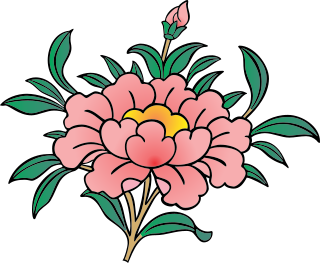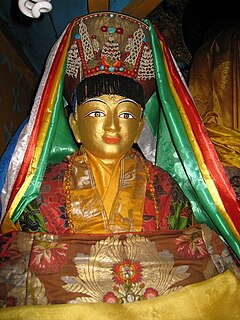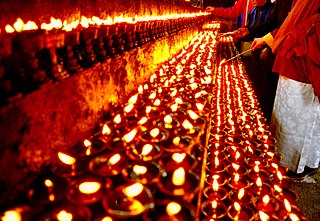The Changling Rinpoche are a Tibetan Buddhist lineage, founded by the Tibetan Rechungpa who lived in the eleventh century. Rechungpa himself was a student of Milarepa.
The Changling Rinpoche are a Tibetan Buddhist lineage, founded by the Tibetan Rechungpa who lived in the eleventh century. Rechungpa himself was a student of Milarepa.

Tibetan Buddhism is the form of Buddhism practiced in Tibet and Bhutan, where it is the dominant religion. It also has adherents in the regions surrounding the Himalayas, in much of Central Asia, in the Southern Siberian regions such as Tuva, and in Mongolia.

Tibet is a region in East Asia covering much of the Tibetan Plateau spanning about 2,500,000 km2 (970,000 sq mi). It is the traditional homeland of the Tibetan people as well as some other ethnic groups such as Monpa, Tamang, Qiang, Sherpa, and Lhoba peoples and is now also inhabited by considerable numbers of Han Chinese and Hui people. Tibet is the highest region on Earth, with an average elevation of 4,380 m (14,000 ft). Located in the Himalayas, the highest elevation in Tibet is Mount Everest, Earth's highest mountain, rising 8,848 m (29,029 ft) above sea level.

Year 1084 (MLXXXIV) was a leap year starting on Monday of the Julian calendar.

The Tibetic languages are a cluster of Tibeto-Burman languages descended from Old Tibetan, spoken across the Himalayan Massif, including the Tibetan Plateau and the Himalayas in Baltistan, Ladakh, Nepal, Sikkim, Bhutan, Assam and Arunachal Pradesh. Classical Tibetan is a major regional literary language, particularly for its use in Buddhist literature.

The Tibetan script is a segmental writing system (abugida) of Indic origin used to write certain Tibetic languages, including Tibetan, Dzongkha, Sikkimese, Ladakhi, Jirel and sometimes Balti. It has also been used for some non-Tibetic languages in close cultural contact with Tibet, such as Thakali. The printed form is called uchen script while the hand-written cursive form used in everyday writing is called umê script.

The Drukpa Lineage, or simply Drukpa, sometimes called either Dugpa or "Red Hat sect" in older sources, is a branch of the Kagyu school of Tibetan Buddhism. The Kagyu school is one of the Sarma or "New Translations" schools of Tibetan Buddhism.

Wylie transliteration is a method for transliterating Tibetan script using only the letters available on a typical English-language typewriter. The system is named for the American scholar Turrell V. Wylie, who created the system and described it in a 1959 paper published in the Harvard Journal of Asiatic Studies. It has subsequently become a standard transliteration scheme in Tibetan studies, especially in the United States.

Jetsun Milarepa was a Tibetan siddha, who was famously known as a murderer when he was a young man, before turning to Buddhism and becoming a highly accomplished Buddhist disciple. He is generally considered one of Tibet's most famous yogis and spiritual poets, whose teachings are known among several schools of Tibetan Buddhism. He was a student of Marpa Lotsawa, and a major figure in the history of the Kagyu school of Tibetan Buddhism. He is also famous for the feat of climbing Mount Kailash.

Düsum Khyenpa was the 1st Gyalwa Karmapa, head of the Karma Kagyu school of Tibetan Buddhism.
Rechung Dorje Drakpa, known as Rechungpa, was one of the two most important students of the 11th century yogi and poet Milarepa and founder of the Shamngpa Kagyu lineage or Rechung lineage of the Kagyu school of Tibetan Buddhism..
Chomo (ZYPY), also D˚romo, or Dhromo Lakha, is a language spoken in Yadong County in the Tibet region of China. It is also spoken in Sikkim, India. It belongs to the southern group of Tibetan languages. Its speakers identify as Tibetans.

Sherpa is a Sino-Tibetan language spoken by the Sherpas, an indinegious native of Nepal. It is also spoken by small number of people in the Indian state of Sikkim. The majority speakers of the Sherpa language live in the Khumbu region of Nepal, spanning from the Chinese (Tibetan) border in the east to the Bhotekosi River in the west. About 200,000 speakers live in Nepal, some 20,000 in Sikkim (1997) and some 800 in Tibetan Autonomous Region (1994). Sherpa is a subject-object-verb (SOV) language. Sherpa is predominately a spoken language, although it is occasionally written using either the Devanagari or Tibetan script.

Chötrul Düchen, also known as Chonga Choepa or the Butter Lamp Festival, is one of the four Buddhist festivals commemorating four events in the life of the Buddha, according to Tibetan traditions. Chötrul Düchen closely follows Losar, the Tibetan New Year. It takes place on the fifteenth day of the first month in the Tibetan calendar during the full moon. The first fifteen days of the year celebrate the fifteen days during which the Buddha displayed miracles for his disciples so as to increase their devotion. During Chötrul Düchen, it is believed that the effects of both positive and negative actions are multiplied ten million times.

Thukpa is a Nepali Tibetan noodle soup, which originated in the eastern part of Nepal and Tibet. Amdo thukpa is a famous variant amongst the Tibetans and the people of Nepal. The dish is also consumed in the neighbouring state of Sikkim, the district of Darjeeling and in the Ladakh region of India. There are numerous varieties of thukpa in Tibetan tradition, including:
The THL Simplified Phonetic Transcription of Standard Tibetan is a system for the phonetic rendering of the Tibetan language.

Lhasa Tibetan is the dialect spoken by educated Lhasa people. It is an official language of the Tibet Autonomous Region.

The great ascetic Drogon Tsangpa Gyare (1161–1211) was the main disciple of Lingchen Repa Pema Dorje and the founder of the Drukpa Lineage of Tibetan Buddhism the main or central branch of which was, until the 17th Century, transmitted by his hereditary family lineage at Ralung in the Tsang region of western Tibet. Later, following the birth of Gyalwang Je Kunga Paljor (1428–1476) considered to be the first of his re-incarnations, Tsangpa Gyare was held to be the first of a succession of Gyalwang Drukpa or Drukchen incarnations who, at the time of the fifth Gyalwang Drukpa Pagsam Wangpo (1593—1653), became established as the reincarnate leaders of the Drukpa lineage in Tibet.
Central Tibetan, also known as Dbus, Ü or Ü-Tsang, is the most widely spoken Tibetic language and the basis of Standard Tibetan.

Umê is a semi-formal form of the Tibetan alphabet. Other Tibetan scripts include the upright book form, uchen and the everyday, handwritten cursive, gyug yig. The name ume means "headless," and is a style of the script used for both calligraphy and shorthand. A distinctive feature of umê compared to uchen is the absence of the horizontal guide line across the top of the letters. Between syllables, the tseg mark often appears as a vertical stroke. There are two main kinds of umê writing:
Milang is a Siangic or Tani language of Upper Siang district, Arunachal Pradesh, India. It is spoken in the 3 villages of Milang, Dalbing, and Pekimodi, located in Mariyang Subdivision, Upper Siang District, Arunachal Pradesh.